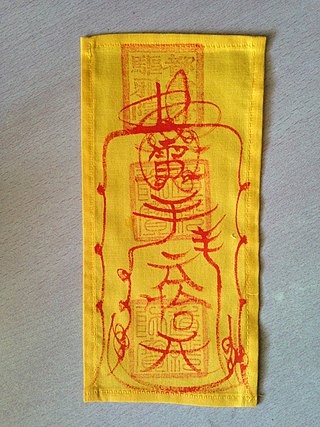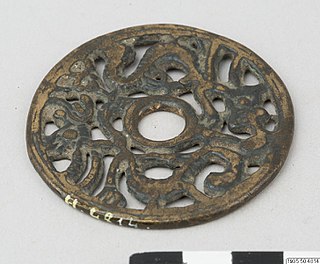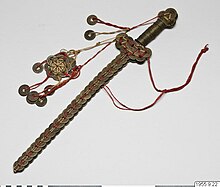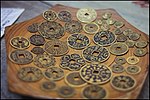
Fulu are Taoist magic symbols and incantations, translatable into English as 'talismanic script', which are written or painted on talismans called 靈符; 灵符; língfú by Taoist practitioners.

The cash or qian was a type of coin of China and the Sinosphere, used from the 4th century BC until the 20th century AD, characterised by their round outer shape and a square center hole. Originally cast during the Warring States period, these coins continued to be used for the entirety of Imperial China. The last Chinese cash coins were cast in the first year of the Republic of China. Generally most cash coins were made from copper or bronze alloys, with iron, lead, and zinc coins occasionally used less often throughout Chinese history. Rare silver and gold cash coins were also produced. During most of their production, cash coins were cast, but during the late Qing dynasty, machine-struck cash coins began to be made. As the cash coins produced over Chinese history were similar, thousand year old cash coins produced during the Northern Song dynasty continued to circulate as valid currency well into the early twentieth century.

Yansheng Coins, commonly known as Chinese numismatic charms, refer to a collection of special decorative coins that are mainly used for rituals such as fortune telling, Chinese superstitions, and Feng shui. They originated during the Western Han dynasty as a variant of the contemporary Ban Liang and Wu Zhu cash coins. Over the centuries they evolved into their own commodity, with many different shapes and sizes. Their use was revitalized during the Republic of China era. Normally, these coins are privately funded and cast by a rich family for their own ceremonies, although a few types of coins have been cast by various governments or religious orders over the centuries. Chinese numismatic charms typically contain hidden symbolism and visual puns. Unlike cash coins which usually only contain two or four Hanzi characters on one side, Chinese numismatic charms often contain more characters and sometimes pictures on the same side.
Korean numismatic charms, also known as Korean amulets, Korean talismans, or simply Korean charms, refer to a family of cash coin-like and other numismatic inspired types of charms that like the Japanese and Vietnamese variants are derived from Chinese numismatic charms, but have evolved around the customs of the Korean culture although most of these charms resemble Korean cash coins and the amulet coins of China, they contain their own categories unique to Korea. There are approximately 500 different known variants of Korean numismatic charms.

Japanese numismatic charms, also known as Japanese amulets, Japanese talismans, or simply Japanese charms, refer to a family of cash coin-like and other numismatic inspired types of charms that like the Korean and Vietnamese variants are derived from Chinese numismatic charms, but have evolved around the customs of the Japanese culture. Although most of these charms resemble Japanese cash coins and the amulet coins of China, they contain their own categories unique to Japan. In the case of these coins, "charm" in this context is a catchall term for coin-shaped items which were not official money. However, these numismatic objects were not all necessarily considered "magical" or "lucky", as some of these Chinese numismatic charms can be used as "mnemonic coins".

Vietnamese numismatic charms, also known as Vietnamese amulets, Vietnamese talismans, or simply Vietnamese charms, refer to a family of cash coin-like and other numismatic inspired types of charms that like the Japanese and Korean variants are derived from Chinese numismatic charms, but have evolved around the customs of the Vietnamese culture although most of these charms resemble Vietnamese cash coins and the amulet coins of China. These "coins" were used at temples, as tokens within the imperial palace, and as everyday charms with supposed magical power such as having the ability to curse evil spirits and bogies. Some of these charms contained the inscriptions of real circulating cash coins but with added imagery.

Numismatic charms are coin-like amulets and talismans from various cultures, which include:

The Zhengde Tongbao is a fantasy cash coin, Chinese, and Vietnamese numismatic charm bearing an inscription based on the reign title of the Zhengde Emperor of the Ming dynasty. The Zhengde Emperor reigned from the year 1505 until 1521, however during this period no circulating cash coins were minted. There were a large amount "cash coins" bearing the Zhengde era name are minted from the late Ming to early Qing dynasty periods as superstitious "lucky coins" with auspicious depictions and instructions, as this inscription remained popular for charms modern reproductions of the Zhengde Tongbao are also very common.

Lei Ting curse charms, or Lôi Đình curse charms, are a type of Chinese and Vietnamese numismatic charms, these charms can be described as a talismanic coin as they are often based on Chinese cash coins but can also have round holes instead of square ones and may also be shaped like gourd charms.

Lock charms are Chinese numismatic charms shaped like ancient Chinese security locks. Their shape resembles a basket or in most cases the Chinese character for "concave" (凹). The pendants tend to be flat, without any moving parts, or the functionality of the locks they symbolize. They are decorated with both Chinese characters and symbols. Like other types of Chinese numismatic charms, lock charms are meant to protect the wearers from harm, misfortune, and evil spirits, and to bless them with good luck, longevity, and a high rank. In particular, this talisman is meant for young boys, to help "lock" them to the earth, to guard them from death.

Open-work charms are a type of Chinese, Japanese, Korean, and Vietnamese numismatic charms characterised by irregularly shaped "holes" or "openings" between their design elements known as openwork. The design of the amulets represent yin while the holes represent yang and their general purpose was to attract good fortune and ward off evil spirits and misfortune. Unlike most other types of Chinese numismatic charms which usually tend to have square center holes if they’re holed, open-work charms tend to almost exclusively have round center holes though open-work charms with square center holes are known to exist and certain thematic open-work charms that feature human-made constructions mostly told to have square holes. Another distinctive feature of open-work charms is that they’re almost purely based on illustrative imagery and only a small minority of them contain legends written in Hanzi characters. While most other forms of Chinese numismatic charms are made from brass open-work charms are predominantly made from bronze.

The Hongwu Tongbao was the first cash coin to bear the reign name of a reigning Ming dynasty Emperor bearing the reign title of the Hongwu Emperor. Hongwu Tongbao cash coins officially replaced the earlier Dazhong Tongbao coins, however the production of the latter did not cease after the Hongwu Tongbao was introduced. The government of the Ming dynasty placed a greater reliance on copper cash coins than the Yuan dynasty ever did, but despite this reliance a nationwide copper shortage caused the production of Hongwu Tongbao cash coins to cease several times eventually leading to their discontinuation in 1393 when they were completely phased out in favour of paper money. In the year 1393 there were a total of 325 furnaces in operation in all provincial mints of China which had an annual output of 189,000 strings of cash coins which was merely 3% of the average annual production during the Northern Song dynasty.

Kangxi Tongbao refers to an inscription used on Chinese cash coins produced during the reign of the Kangxi Emperor of the Manchu-led Qing dynasty. Under the Kangxi Emperor the weights and standards of the brass cash coins changed several times and the bimetallic system of Qing dynasty coinage was established. Today Kangxi Tongbao cash coins are commonly used as charms and amulets where different forms of superstition have developed arounds its mint marks and calligraphy.

Qianlong Tongbao is an inscription used on cash coins produced under the reign of the Qianlong Emperor of the Qing dynasty. Initially the Qianlong Tongbao cash coins were equal to its predecessors in their weight and quality but as expensive military expenditures such as the Ten Great Campaigns began to take their financial toll on the government of the Qing dynasty the quality of these cash coins started to steadily decrease. The weight of the Qianlong Tongbao was changed several times and tin was added to their alloy to both reduce costs and to prevent people from melting down the coins to make utensils. As the intrinsic value of these coins was higher than their nominal value many provincial mints started reporting annual losses and were forced to close down, meanwhile the copper content of the coinage continued to be lowered while the copper mines of China were depleting. The Qianlong era also saw the conquest of Xinjiang and the introduction of cash coins to this new region of the Qing Empire.

Indonesian numismatic charms, also known as Indonesian magic coins, are a family of coin-like objects based on a similar Chinese family of coin charms, amulets, and talismans but evolved independently from them. Indonesian numismatic charms tend to have been influenced a lot by Hinduism, Islam, and the native culture and often depict religious imagery from Hinduism for this reason. The "magic coins" and temple coins from Indonesia are largely based on the Chinese cash coins introduced to the region during the Tang dynasty era in China, and during the local Majapahit era they began circulating in the region. Unlike with Chinese numismatic charms, the coin charms of Indonesia have not been as well documented both historically and in the modern era. A major modern day work about Indonesian numismatic charms in English is Joe Cribb's Magic coins of Java, Bali, and the Malay Peninsula which is a catalogue based on the collection of coin-shaped charms from the island Java acquired by Sir Thomas Stamford Raffles during his lifetime held in the British Museum, the book is further supplemented with data and information available from various other sources.

Buddhist coin charms are a category of Chinese, Japanese, Korean, and Vietnamese numismatic charms that depict Buddhist religious imagery or inscriptions. These coin charms often imitate the design of Chinese cash coins, but can exist in many different shapes and sizes. In these countries similar numismatic charms existed for Confucianism and Taoism, and at times Buddhist coin charms would also incorporate symbolism from these other religions.

Taoist coin charms, or Daoist coin charms are a family of categories of Chinese and Vietnamese numismatic charms that incorporate elements of the Taoist religion. Taoist coin charms come in various shapes, sizes, and formats and can contain inscriptions or wholly pictorial designs. While a large number of Taoist coin charms have their inscriptions written in traditional Chinese characters, a subset of Taoist coin charms have inscriptions written in Taoist "magic" writing. In these countries similar numismatic charms existed for Buddhist and Confucianism, and at times Taoist coin charms would also incorporate symbolism from these other religions.

Marriage coin charms are a category of Chinese, Japanese, Korean, and Vietnamese numismatic charms that depict marriage, harmonious, and/or sexual imagery. These coin charms often imitate the design of Chinese cash coins, but can exist in many different shapes and sizes.

The usage of cash coins in the Chinese pseudoscientific practice of feng shui is commonplace influencing many superstitions involving them. Believers in feng shui believe in a primal life force called qi and apply their beliefs to the design of residential houses, as well as to commercial and public buildings, sometimes incorporating cash coins into the flow of this supposed qi.

The Zhouyuan Tongbao is a copper-alloy cash coin produced during the reign of Emperor Shizong of the Later Zhou dynasty, a historical Chinese state that existed in the Five Dynasties and Ten Kingdoms period. The design of the Zhouyuan Tongbao cash coins closely resembles that of the Kaiyuan Tongbao (開元通寳) series produced during the earlier Tang dynasty period. The Zhouyuan Tongbao cash coins were produced from recycled Buddhist statues confiscated from Buddhist temples. For this reason the Zhouyuan Tongbao is commonly referred to as "Arhat money" or as the "money that destroyed Buddha". Nicknames only reserved for a handful of Chinese cash coins, as confiscation of Buddhist statues for coin production only happened around 7 times in Chinese history.




















